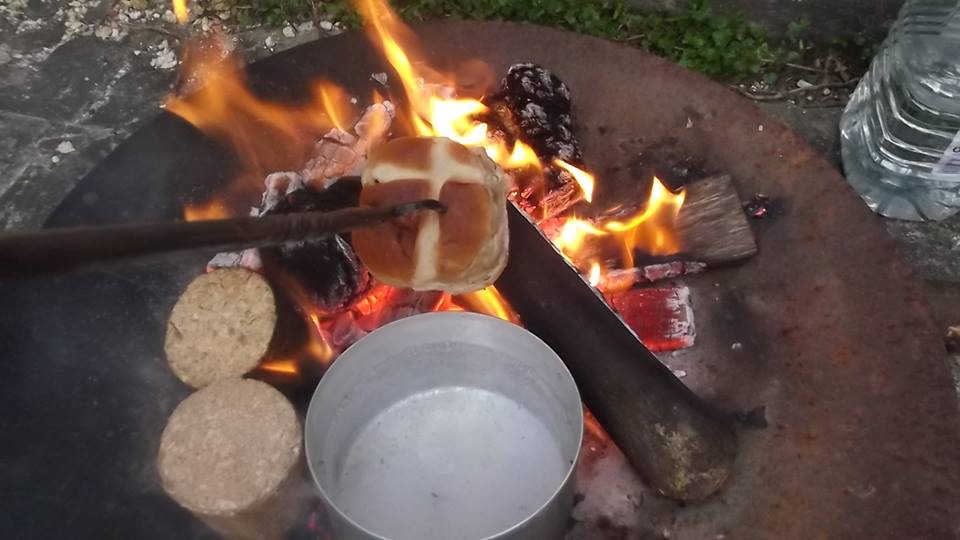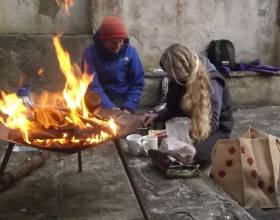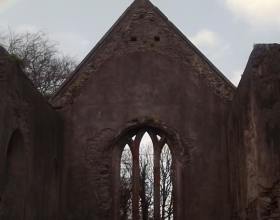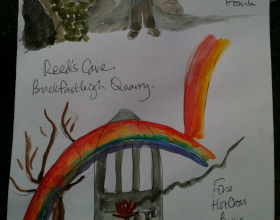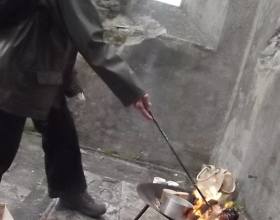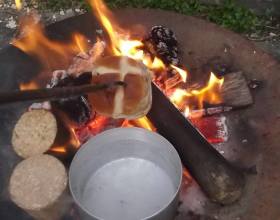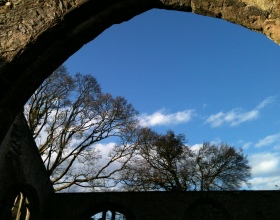For Good Friday Wild Church made an epic five hour pilgrimage, based on an eco-feminist exploration of the Stations of the Cross. We started in the Lady Chapel at Staverton Church, gazing at Marco Donner’s lovely paintings of the Annunciation and the Nativity, which made a bittersweet beginning to a journey of reflection on Christ’s crucifixion. As we moved outside to begin our silent walk, from under the ancient yew and beside the gravestones in the Churchyard, I (Sam) thought of T.S Eliot’s words in Little Gidding
“We die with the dying:
See, they depart, and we go with them.
We are born with the dead:
See, they return, and bring us with them.
The moment of the rose and the moment of the yew tree
Are of equal duration.”
So we began our pilgrimage, planning to walk in silence together and pause intuitively along the way. At each natural station I read a few words about the traditional focus of the Stations of the Cross, followed by a question for shared reflection or personal prayer. This was a spirit led journey and the land herself seemed to lead and teach us along the way, more perfectly than any of us could have planned.
Below are the notes from our pilgrimage, with some images and memories woven in…
The Stations of the Cross
(Notes by Rev. Sam Wernham, with thanks to Joseph O’Hanlon for inspiration from his book, Walk One Hour – Stations of the Cross for Pilgrim People, and to Mother Earth for her natural guidance and inspiration. Photos by Sam & Beth and visual journal sketches by Helen Raphael Sands)
Traditionally there have been fourteen stations. Nine of the fourteen stations draw inspiration from incidents recorded in one or other of the four Gospels. The remaining five come from ancient legends and Christian imagination. The fourteen stations take us on a journey from Jesus being condemned to his death. Below is a very simple reminder of each station and a question for reflection, approaching the Stations from a more eco feminist and personal perspective:
Notes for the journey:
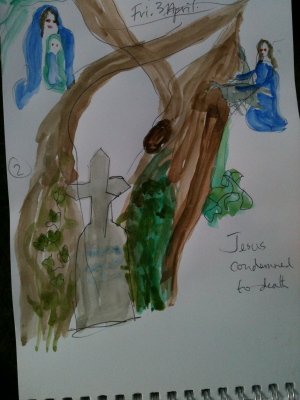 The First Station – Jesus is condemned to death
The First Station – Jesus is condemned to death
Our first station was under the yew, in the shadow of the Church, with a sense of the weight of our current traditions and authorities. Last night’s parliamentary debate was fresh in all our minds with most of us feeling uninspired by the combative and competitive nature of party politics. Thoughts were shared around the consensus of our human centred culture with its disregard for the christlike wordless beings of the natural world who daily we condemn to death.
Jesus is condemned by both the religious and political authorities of the time. The former are represented by Caiaphas, the leading priest of the Jewish Temple in Jerusalem, and the latter by Pontius Pilate, the prefect for the Romans who then controlled the Jewish people and their homeland. Jesus was a threat to a fragile consensus.
Bible reference: Mark 14:53-65 and Mark 15:1-15
Question for personal reflection – Do you challenge a current consensus or are you being challenged? Are you condemned or condemning?
The Second Station – Jesus takes up his cross
Our second station was at ‘Nappers Cross’ where the old road crosses the steam railway line with the waters of the leat flowing alongside. Questions arose about whether we had ever been asked to really suffer for another and reflections arose about empathy and the willingness and capacity to come alongside others/ each other in their/our suffering.
Crucifixion was capital punishment and a public spectacle, reserved for the underclasses and intended to humiliate the victim and their family and friends and uphold the power of Rome (although crucifixion was also used by many others cultures also). Historically Jesus had this cruel death forced upon him, but for Christians he chose to take up his cross, in empathy with the suffering of all.
Question for personal reflection – How do you experience and express your empathy with the suffering of others, or the earth. What does ‘taking up your cross’ ask of you?
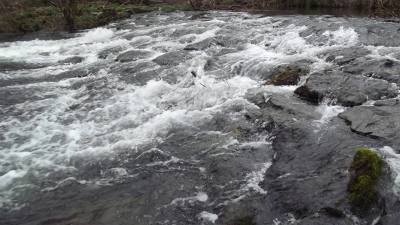 The Third Station – Jesus falls the first time
The Third Station – Jesus falls the first time
Our third station was by troubled waters where the river and leat divide, where rocks below the surface break up the smooth flow and the river falls into a new channel. On the opposite bank we watched an egret fishing… small silvery deaths giving life.
This incident is not recorded in the Gospels but early Christians imagined that the way was hard and Jesus fell. Falling brings us closer to the earth, to humus/soil and a sense of humility and interdependence.
Question for personal reflection – Do you sometimes stumble and fall in your journey or witness this in others? How do you respond… could it include compassion?
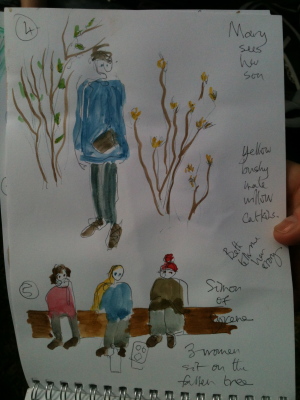 The Fourth Station – Jesus meets his Mother
The Fourth Station – Jesus meets his Mother
Our fourth station was the abandoned mill site near Staverton Bridge. There’s nothing left now of a once thriving industry that supported so many lives but the converted mill building and a wasteland of tarmac and concrete. Here we found willow hybrids breaking through the broken rubble. Mother earth coming to meet and heal wounds. We were gazing at catkins – a sacred meeting of male and female on willow trees standing side by side.
Although St. John’s Gospel tells of Mary being at the foot of the cross, none of the Gospels describe such a meeting along the way. But it is easy to imagine that a brave and heart broken Mary would have been there to support her son.
Question for personal reflection – Is there someone or something that supports you in times of need? What can you draw upon? Can you be there for what or who you care about?
The Fifth Station – Simon of Cyrene helps Jesus to carry his cross
Our fifth station was stopping to rest at the crest of the hill in Dartington woods where a felled tree gave us (unwillingly?) a helpful place to sit.
Those condemned to death by crucifixion would usually be bound to the cross beam and pushed through the city to where the upright was already set. It was not usual Roman practice to allow or force someone else to carry the cross beam of a criminal as Simon is forced to do. There was a Jewish community in Cyrene in Libya.
Question for personal reflection – Have you experienced unexpected help in tough times? Could you be the unexpected help for another, perhaps even when unwilling?
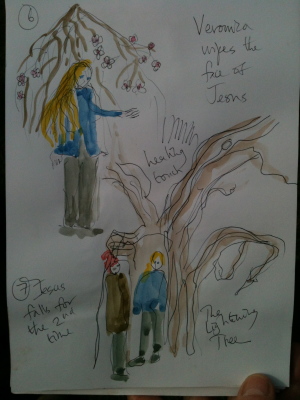 The Sixth Station – Veronica wipes the face of Jesus
The Sixth Station – Veronica wipes the face of Jesus
Our sixth station was beside flowering ‘chequers’ in the Forest Garden nursery at Week… with delicate white blossoms like a healing touch…
This also is not a biblical incident, although it draws inspiration from a passage in Luke’s gospel of women mourning for Jesus as he passes (which we’ll revisit in station eight). Time singled out one woman called Berenice in Christian stories (or Veronica in Latin). In an ancient Greek document she is understood as being the woman Jesus healed in Mark 5:24-34. This station witnesses to the mysteries of healing and participation in the suffering of others.
Question for personal reflection – Is there someone or something in life that needs your healing touch and willingness to participate and compassionately understand suffering?
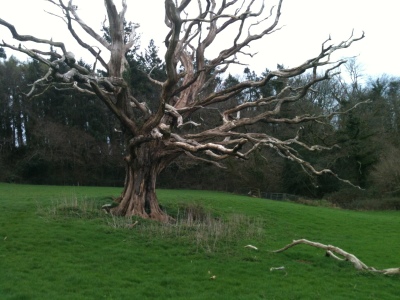 The Seventh Station – Jesus falls the second time
The Seventh Station – Jesus falls the second time
Our seventh station was a great oak standing both beautiful and dead in a meadow above Water Lane… close beside it the steel structure of a huge electricity pylon. Recognising that we too were starting to flag on our long walk and yet are not much more than half way there and perhaps with stray thoughts of wanting to give up creeping in!
Christians reflect not only on how Jesus may have fallen, but also on the Biblical accounts of how some of those who were closest to him, such as Peter and Judas, experienced a falling or failing in their love for him, perhaps due to mainly to fear. Both Peter and Jesus found a way to move on.
Question for personal reflection – Can you recognise this second falling or failing of love? What helps with moving on?
The Eighth Station – Women of Jerusalem weep for Jesus
Our eighth station was pausing at a meeting of ways… four women pausing to remember Jesus. Water was flowing over the lane and trickling into an open drain with a steady, musical fall of watery tears.
All four Gospels tell stories of the women who were close to Jesus. It was often the women who initiated healing and miracles and who were close and aware of transformative and intimate moments in the ministry and life of Jesus. He was committed to counter cultural ways of being that emphasised love, generosity and service – often seen as feminine qualities – rather than dominance and power. While the male disciples argued over who was the most important, it was the mainly the women who witnessed the depth and passion of Christ.
Bible reference: Mark 15:40-41
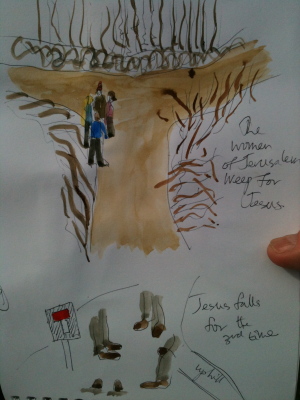 Question for personal reflection – What feminine values or witness could help with current personal, collective or environmental challenges?
Question for personal reflection – What feminine values or witness could help with current personal, collective or environmental challenges?
The Ninth Station – Jesus falls for the third time
Our ninth station and with so little reason, relative to Jesus’ journey, we were feeling the weight of our packs, the seemingly endless lanes… another meeting of the ways and a ‘dead end’ sign. Helen’s visual journal recalls how the perspective from having fallen to the earth is of others’ feet, the ‘worm’s eye view’
Three’s often represent a finality in stories, including biblical ones. Here it suggests the utter desperation, despair and exhaustion of Jesus. This is a profound ‘dark night of the soul’ moment.
Question for personal reflection – Do you recognise a dark night of the soul moment from your life, or the life of the world. How do we find a way through?
The Tenth Station – Jesus is stripped of his garments
The tenth station by the roadside, legs getting very heavy now. Reflecting on experiences of being ‘stripped down’ by life… losses, divorce, ageing… and how much worse for any who have to to suffer such traumas without support…
This is a very ancient motif, as in Inanna being stripped of her garments and powers as she descends to the Underworld in Ancient Sumerian myth. Times of trial and transformation often involve being stripped of old identities, understandings and attachments. In the Gospels Jesus is beaten, stripped, mocked, humiliated and insulted.
Bible reference: Mark 15:16-20 and 22-32
Question for personal reflection – Have you experienced being stripped down? Are there perhaps things to be stripped of or let go of in our current times of crisis and transformation?
The Eleventh Station – Jesus is nailed to the cross
Coming back towards the river Dart now for this eleventh station and approaching the sewage works. Pausing to offer up prayers for all those who suffer from cruelty and persecution and especially the quiet and often overlooked ones in the family of all beings… creatures, plants, places.
Of the many thousands of people crucified by the Romans, the remains of one young jewish man from Jerusalem have been found. His right heel bone had been pierced by a four and a half inch nail with a wooden washer by its head to prevent him from pulling his foot off the nail. It seems his feet were nailed to each side of the cross. There might have been a footrest, not as an act of mercy but to enable the victim to breathe by lifting himself which would prolong the agony and suffering.
For personal reflection and prayer – there are many peoples, creatures and places experiencing persecution and deep suffering in our times. Perhaps this could be a moment to reflect on one of these and spend some time in silent witness and prayer.
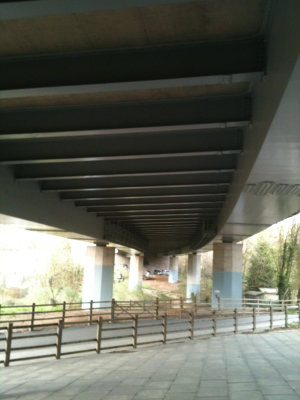 The Twelfth Station – Jesus dies on the cross
The Twelfth Station – Jesus dies on the cross
Our twelfth station was in the dead zone under the A38. A great swathe of concrete devoid of the life that once must have flourished here. Above us the endless thunder of the traffic, rushing by, heedless of the lives its way had extinguished.
Mark’s Gospel (thought to be the oldest account) describes how in his final hour, Jesus felt utterly forsaken. He uttered a loud cry and breathed his last. His mother and close friends witness his suffering and are powerless to prevent it, which is in itself a form of torture.
Bible reference: Mark 15:33-39
For personal reflection and prayer – perhaps this could be a moment to reflect on those feeling forsaken or facing death, including endangered species and those facing extinction… and to reflect on the impact this has on us all.
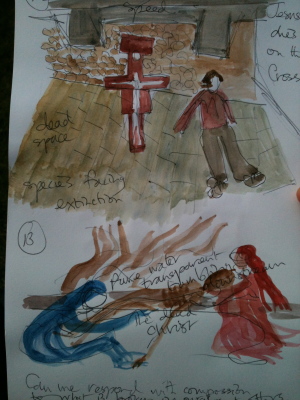 The Thirteenth Station – Jesus is taken down from the cross
The Thirteenth Station – Jesus is taken down from the cross
Our thirteenth station was a bridge over the River Mardle in Buckfastleigh where we stopped to watch the soft flow of the water and reflect on the women who tended and washed and wrapped Jesus’ body with such love & care.
There are beautiful images by artists showing the male and female friends and family of Jesus receiving, holding and tending to his body after it has been taken down from the cross. Mary, his mother, is traditionally shown in deep blue and Mary Magdalene in red.
Question for personal reflection – can we respond together to what is broken in us and in the world with such tender care and compassion?
The Fourteenth Station – Jesus is laid in the tomb
Our final station was just below our destination in the ancient limestone caves below Holy Trinity Church. Many bones have been found in this ‘hollow hill’ beneath the Church. The caves are both stoney and bare and yet also full of the promise of life with hibernating bats and burrows for foxes and badgers.
The traditional stations end with this very final image of the body of Jesus being laid in a tomb. This was not actually common practice for crucified criminals in Roman times, who were usually left to rot with their families denied access to the body. Mark’s Gospel describes how Joseph of Arimathea was a member of the Jewish council with access to Pilate and so requested the body of Jesus and arranged for it to be placed in a tomb.
Bible reference: Mark 16:42-47
The body of Jesus returns to the earth like a seed ready for new life in this spring season of the the earth and of the spirit. (John 12: 23-24 “I tell you the truth, unless a grain of wheat falls to the ground and dies, it remains only a single seed. But if it dies, it produces many seeds.”) Again this is an ancient motif, as in Inanna’s death and rebirth in the Great Below or Persephone’s descent and return from the Underworld.
Question for personal reflection – as we conclude our journey, are you aware of a death and rebirth happening this year in your life or the life of the planet/world? Is there a pledge or prayer you could make now to help support this?
Our pilgrimage ended in the final climb up into the primrose studded graveyard and into the beautiful burn ruins of Holy Trinity Church. Destroyed by arson in the 1990’s this 800 year old parish church, on its even older sacred site, feels like a real embodiment of the mysteries of crucifixion and resurrection. We kindled out fire wok to toast our Good Friday hot cross buns where the altar once stood, with wind blowing streams of bright sparks across the sanctuary. A bright band of colour on the horizon grew into a rainbow that arched over the Church, as the sun set and the full moon rose into the blue dusk.

